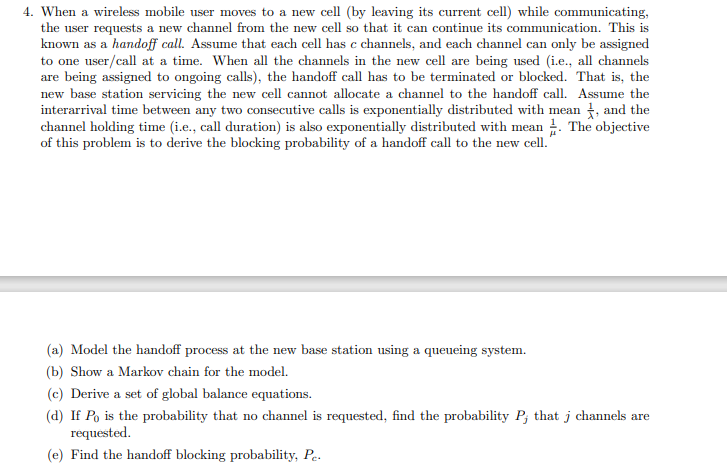the user requests a new channel from the new cell so that it can continue its communication. This is known as a handoff call. Assume that each cell has e channels, and each channel can only be assigned to one user/call at a time. When all the channels in the new cell are being used (i.e., all channels are being assigned to ongoing calls), the handoff call has to be terminated or blocked. That is, the new base station servicing the new cell cannot allocate a channel to the handoff call. Assume the interarrival time between any two consecutive calls is exponentially distributed with mean , and the channel holding time (i.e., call duration) is also exponentially distributed with mean . The objective of this problem is to derive the blocking probability of a handoff call to the new cell.
the user requests a new channel from the new cell so that it can continue its communication. This is known as a handoff call. Assume that each cell has e channels, and each channel can only be assigned to one user/call at a time. When all the channels in the new cell are being used (i.e., all channels are being assigned to ongoing calls), the handoff call has to be terminated or blocked. That is, the new base station servicing the new cell cannot allocate a channel to the handoff call. Assume the interarrival time between any two consecutive calls is exponentially distributed with mean , and the channel holding time (i.e., call duration) is also exponentially distributed with mean . The objective of this problem is to derive the blocking probability of a handoff call to the new cell.
Database System Concepts
7th Edition
ISBN:9780078022159
Author:Abraham Silberschatz Professor, Henry F. Korth, S. Sudarshan
Publisher:Abraham Silberschatz Professor, Henry F. Korth, S. Sudarshan
Chapter1: Introduction
Section: Chapter Questions
Problem 1PE
Related questions
Question

Transcribed Image Text:4. When a wireless mobile user moves to a new cell (by leaving its current cell) while communicating,
the user requests a new channel from the new cell so that it can continue its communication. This is
known as a handoff call. Assume that each cell has c channels, and each channel can only be assigned
to one user/call at a time. When all the channels in the new cell are being used (i.e., all channels
are being assigned to ongoing calls), the handoff call has to be terminated or blocked. That is, the
new base station servicing the new cell cannot allocate a channel to the handoff call. Assume the
interarrival time between any two consecutive calls is exponentially distributed with mean t, and the
channel holding time (i.e., call duration) is also exponentially distributed with mean . The objective
of this problem is to derive the blocking probability of a handoff call to the new cell.
(a) Model the handoff process at the new base station using a queueing system.
(b) Show a Markov chain for the model.
(c) Derive a set of global balance equations.
(d) If Po is the probability that no channel is requested, find the probability P; that j channels are
requested.
(e) Find the handoff blocking probability, Pe.
Expert Solution
This question has been solved!
Explore an expertly crafted, step-by-step solution for a thorough understanding of key concepts.
Step by step
Solved in 2 steps with 1 images

Knowledge Booster
Learn more about
Need a deep-dive on the concept behind this application? Look no further. Learn more about this topic, computer-science and related others by exploring similar questions and additional content below.Recommended textbooks for you

Database System Concepts
Computer Science
ISBN:
9780078022159
Author:
Abraham Silberschatz Professor, Henry F. Korth, S. Sudarshan
Publisher:
McGraw-Hill Education

Starting Out with Python (4th Edition)
Computer Science
ISBN:
9780134444321
Author:
Tony Gaddis
Publisher:
PEARSON

Digital Fundamentals (11th Edition)
Computer Science
ISBN:
9780132737968
Author:
Thomas L. Floyd
Publisher:
PEARSON

Database System Concepts
Computer Science
ISBN:
9780078022159
Author:
Abraham Silberschatz Professor, Henry F. Korth, S. Sudarshan
Publisher:
McGraw-Hill Education

Starting Out with Python (4th Edition)
Computer Science
ISBN:
9780134444321
Author:
Tony Gaddis
Publisher:
PEARSON

Digital Fundamentals (11th Edition)
Computer Science
ISBN:
9780132737968
Author:
Thomas L. Floyd
Publisher:
PEARSON

C How to Program (8th Edition)
Computer Science
ISBN:
9780133976892
Author:
Paul J. Deitel, Harvey Deitel
Publisher:
PEARSON

Database Systems: Design, Implementation, & Manag…
Computer Science
ISBN:
9781337627900
Author:
Carlos Coronel, Steven Morris
Publisher:
Cengage Learning

Programmable Logic Controllers
Computer Science
ISBN:
9780073373843
Author:
Frank D. Petruzella
Publisher:
McGraw-Hill Education